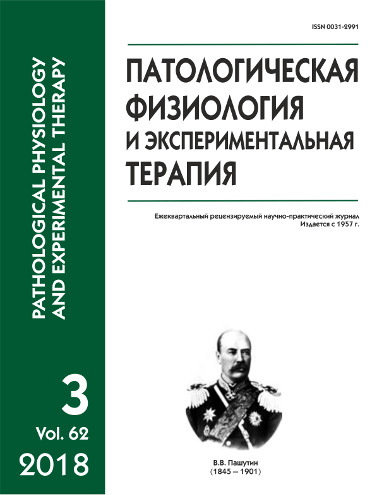Резекция печени изменяет механизмы выведения аммиака почками крыс с хроническим тетрахлорметановым гепатитом
DOI:
https://doi.org/10.25557/0031-2991.2018.03.72-79Ключевые слова:
гепатит, резекция печени, почки, аммиак, глутамин, мочевина, механизмы выделенияАннотация
Цель исследования — изучение влияния резекции печени (РП) на аммиакэкскретирующую функцию почек при хроническом тетрахлорметановом гепатите. Методика. Опыты выполнены на 265 беспородных белых крысах (самках) массой 180—220 г. Хронический гепатит воспроизводили подкожным введением 50% раствора тетрахлорметана (CCl4) на оливковом масле (0,1 мл/100 г массы тела, через сутки, c двумя двухнедельными перерывами между 6, 7 и 13—14 инъекциями). На 65-е сут. (последние) введения тетрахлорметана, удаляли часть левой доли печени (15—20% массы органа). На 3-и, 7-е и 14-е сут. после РП или лапаротомии («ложнооперированные» животные) в почках, артериальной и венозной крови, моче исследовали содержание аммиака, глутамина и мочевины. Результаты. Прогрессирование эндогенной аммиачной интоксикации после РП на фоне тетрахлорметанового гепатита сопровождается повышенной экскрецией аммиака почками. Однако это не устраняет артериальную гипераммониемию и не предотвращает накопление почками аммиака. Инкреция глютамина из почек в кровоток прекращается. К 14-м сут. послеоперационного периода возрастает потребление глютамина из артериальной крови, что приводит к его накоплению в почках. Стимулируя выведение мочевины из организма с мочой, РП одновременно активирует её образование в почках, с дальнейшим поступлением как в кровоток, так и в мочу. В зависимости от сроков послеоперационного периода это сопровождается изменением скорости реабсорбции мочевины в почках. Заключение. Полученные результаты свидетельствуют, что при РП на фоне тетрахлорметанового гепатита почки не предотвращают прогрессирование эндогенной аммиачной интоксикации, патологическое накопление аммиака и глутамина её клетками, но сохраняют способность принимать участие в регуляции повышенного содержания мочевины в артериальной крови.Загрузки
Опубликован
2018-10-05
Выпуск
Раздел
Оригинальные исследования
Как цитировать
[1]
2018. Резекция печени изменяет механизмы выведения аммиака почками крыс с хроническим тетрахлорметановым гепатитом. Патологическая физиология и экспериментальная терапия. 62, 3 (Oct. 2018), 72–79. DOI:https://doi.org/10.25557/0031-2991.2018.03.72-79.













